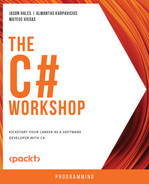The
C#
Workshop
Kickstart your career as a software developer with C#
Jason Hales, Almantas Karpavicius, and Mateus Viegas
The C# Workshop
Copyright © 2022 Packt Publishing
All rights reserved. No part of this book may be reproduced, stored in a retrieval system, or transmitted in any form or by any means without the prior written permission of the publisher, except in the case of brief quotations embedded in critical articles or reviews.
Every effort has been made in the preparation of this book to ensure the accuracy of the information presented. However, the information contained in this book is sold without warranty, either express or implied. Neither the authors nor Packt Publishing and its dealers and distributors will be held liable for any damages caused or alleged to be caused directly or indirectly by this book.
Packt Publishing has endeavored to provide trademark information about all companies and products mentioned in this book by the appropriate use of capitals. However, Packt Publishing cannot guarantee the accuracy of this information.
Authors: Jason Hales, Almantas Karpavicius, and Mateus Viegas
Reviewers: Omprakash Pandey and Dara Oladapo
Development Editor: M Keerthi Nair
Acquisitions Editors: Royluis Rodrigues, Kunal Sawant, and Anindya Sil
Production Editor: Shantanu Zagade
Editorial Board: Vijin Boricha, Megan Carlisle, Ketan Giri, Heather Gopsill, Akin Babu Joseph, Bridget Kenningham, Manasa Kumar, Alex Mazonowicz, Monesh Mirpuri, Aaron Nash, Abhishek Rane, Brendan Rodrigues, Ankita Thakur, Nitesh Thakur, and Jonathan Wray
First published: September 2022
Production reference: 2281022
ISBN: 978-1-80056-649-1
Published by Packt Publishing Ltd.
Livery Place, 35 Livery Street
Birmingham B3 2PB, UK
